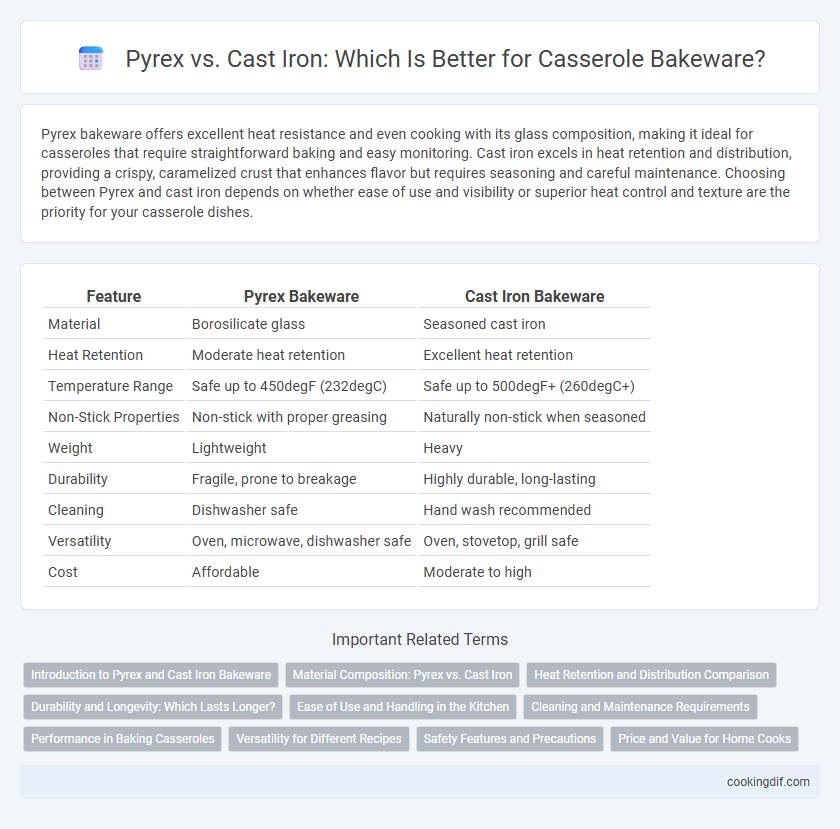Pyrex bakeware offers excellent heat resistance and even cooking with its glass composition, making it ideal for casseroles that require straightforward baking and easy monitoring. Cast iron excels in heat retention and distribution, providing a crispy, caramelized crust that enhances flavor but requires seasoning and careful maintenance. Choosing between Pyrex and cast iron depends on whether ease of use and visibility or superior heat control and texture are the priority for your casserole dishes.
Table of Comparison
| Feature | Pyrex Bakeware | Cast Iron Bakeware |
|---|---|---|
| Material | Borosilicate glass | Seasoned cast iron |
| Heat Retention | Moderate heat retention | Excellent heat retention |
| Temperature Range | Safe up to 450degF (232degC) | Safe up to 500degF+ (260degC+) |
| Non-Stick Properties | Non-stick with proper greasing | Naturally non-stick when seasoned |
| Weight | Lightweight | Heavy |
| Durability | Fragile, prone to breakage | Highly durable, long-lasting |
| Cleaning | Dishwasher safe | Hand wash recommended |
| Versatility | Oven, microwave, dishwasher safe | Oven, stovetop, grill safe |
| Cost | Affordable | Moderate to high |
Introduction to Pyrex and Cast Iron Bakeware
Pyrex bakeware, made from tempered glass, offers excellent heat resistance and allows for easy monitoring of food while baking due to its transparency. Cast iron bakeware provides superior heat retention and even distribution, making it ideal for slow-cooking casseroles and dishes requiring consistent temperatures. Both materials are durable and versatile, but Pyrex excels in lightweight convenience whereas cast iron stands out for its longevity and seasoning benefits.
Material Composition: Pyrex vs. Cast Iron
Pyrex bakeware is made from borosilicate glass, which offers excellent heat resistance and non-reactive properties, making it ideal for evenly baking casseroles without imparting flavors. Cast iron cookware consists of dense iron alloy, providing superior heat retention and distribution that creates a crispy crust and consistent cooking temperatures. While Pyrex excels in transparency for monitoring cooking progress, cast iron outperforms in durability and versatility for stovetop-to-oven use.
Heat Retention and Distribution Comparison
Pyrex bakeware offers excellent heat distribution due to its glass composition, allowing even cooking without hot spots, but it has moderate heat retention and cools down faster after being removed from the oven. Cast iron excels in heat retention, maintaining consistent warmth for longer periods, which is ideal for slow-cooked casseroles, though it heats more slowly and requires preheating for optimal performance. Choosing between Pyrex and cast iron depends on whether quick heat responsiveness or sustained temperature maintenance is prioritized in casserole preparation.
Durability and Longevity: Which Lasts Longer?
Pyrex bakeware offers excellent durability with its tempered glass construction that resists thermal shock and staining, making it ideal for long-term use in the oven and dishwasher. Cast iron casseroles boast exceptional longevity due to their robust, heavy-duty design and natural non-stick seasoning that improves with time, often lasting several decades when properly maintained. While Pyrex is durable for everyday baking needs, cast iron outperforms in lifespan and wear resistance, making it a superior investment for lasting kitchen cookware.
Ease of Use and Handling in the Kitchen
Pyrex bakeware offers lightweight design and clear glass construction, allowing effortless monitoring of cooking progress and easy handling when transferring dishes in or out of the oven. Cast iron, while heavier and requiring seasoning for maintenance, provides excellent heat retention but can be cumbersome to lift and clean, especially when hot. Both materials demand careful handling, but Pyrex's ergonomic advantage and dishwasher-safe nature enhance overall ease of use in busy kitchens.
Cleaning and Maintenance Requirements
Pyrex bakeware offers a smooth, non-porous glass surface that resists staining and is dishwasher safe, making cleaning effortless and maintenance minimal. Cast iron requires thorough hand washing without soap to preserve its seasoned surface, and periodic seasoning is essential to prevent rust and maintain its non-stick properties. Choosing between Pyrex and cast iron depends on whether ease of cleaning or long-term maintenance fits your kitchen routine better.
Performance in Baking Casseroles
Pyrex glass bakeware offers even heat distribution and superior resistance to thermal shock, ensuring consistent baking results and easy monitoring of casserole doneness. Cast iron excels in heat retention and develops a natural non-stick surface over time, providing excellent browning and crisping for casseroles. Both materials perform well, but Pyrex is ideal for delicate dishes requiring precise temperature control, while cast iron enhances flavor and texture through superior heat retention.
Versatility for Different Recipes
Pyrex bakeware offers exceptional versatility for a wide range of recipes, from savory casseroles to delicate desserts, due to its non-reactive glass material that evenly distributes heat and allows for easy monitoring during cooking. Cast iron casserole dishes excel in recipes requiring high heat retention and consistent heat distribution, perfect for slow-cooked stews or baked dishes that transition from stovetop to oven. Both materials enhance recipe adaptability, but Pyrex is ideal for lighter, temperature-sensitive meals, while cast iron is preferred for rich, hearty casseroles demanding robust heat control.
Safety Features and Precautions
Pyrex bakeware is made from tempered glass, offering excellent heat resistance and non-reactive properties, but it requires careful handling to avoid thermal shock that can cause shattering. Cast iron casserole dishes provide superior heat retention and durability but must be properly seasoned to prevent rust and maintain a natural non-stick surface. Both materials demand oven-safe use recommendations, with Pyrex best suited for moderate temperature changes and cast iron requiring thorough cleaning and drying after each use to ensure longevity and safety.
Price and Value for Home Cooks
Pyrex bakeware typically offers budget-friendly pricing and excellent heat resistance, making it a practical choice for everyday home cooks seeking convenience and durability. Cast iron casserole dishes, while often priced higher, provide superior heat retention and even cooking, delivering long-term value due to their versatility and lifespan. Home cooks prioritizing cost-effectiveness will benefit from Pyrex's affordability, but those investing for lasting performance may find cast iron a worthwhile investment.
Pyrex vs cast iron for bakeware Infographic

 cookingdif.com
cookingdif.com